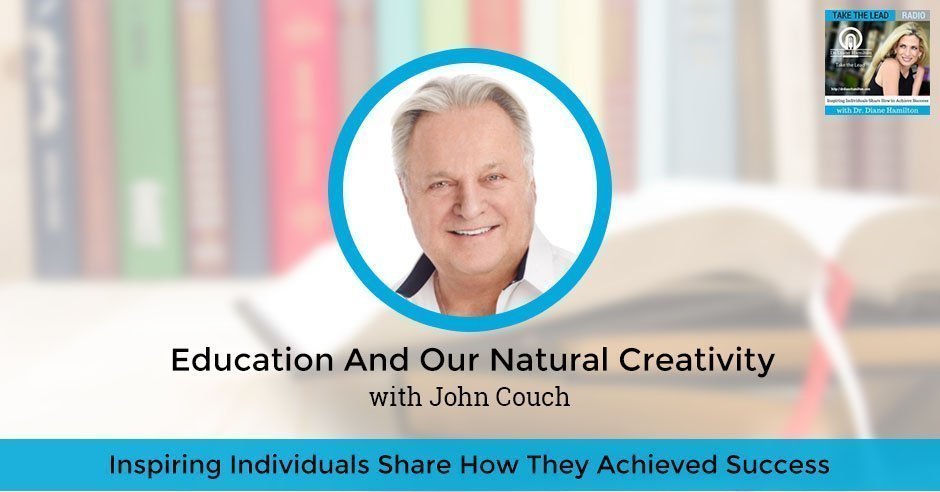
We have John Couch. He’s one of the first Apple employees. He has written a book about rewiring education. He’s fascinating and I’m looking forward to our conversation.
Listen to the podcast here
Education And Our Natural Creativity with John Couch
I am here with John Couch who is the 54th employee at Apple and later became Vice President of Software. He retired in his 30s and went on to revitalize a faith-based school in California and worked at several other projects. Steve Jobs brought him back as the first VP of Education at Apple. He’s been working on a new book called Rewiring Education: How Technology Can Unlock Every Student’s Potential. I’m interested in your book and it’s so nice to have you here, John.
It’s my pleasure.
My first question for you is can you describe the motion of a spinning top and free space?
I didn’t memorize it and I panicked in my final exam. It’s unfortunate because what I should have done was just relax and thought about it and thought about the force in which direction I would spin it and try to derive at least partial equations. That’s from about 1968 and the mode of success for me in those days was to memorize everything and then regurgitate it.
We should probably explain why I even asked you that. Do you want to give the backstory on it?
It’s funny because I was looking through my high school yearbooks a few years back and I found in my senior year book 1965 the salutation from a good friend, William Selectman, who went on to West Point and he wrote, “Couch and Aristotle are now synonymous. Keep memorizing those problems.” That’s exactly what we did. Whether it was physics or chemistry or algebra, we just memorize the formulas and then repeated them back on the test. We were rewarded with National Honor Society and scholarships. That worked well up until my junior year in college as a physics major when I walked into the final exam and there was one question. That question was, “Describe the motion of a spinning top in free space.” A whole class of smart people panicked because it had never been covered in the lecture and it wasn’t present in the book.
[bctt tweet=”We have the God-given talent to build tools not only in our physical ability but also our intellectual ability.” via=”no”]It just so happened that same semester, a friend of mine encouraged me to take a class with him called Horticultural Science 120. I said, “What is that?” He goes, “Ignore the name. It’s the only department that can afford a computer. It’s computer programming.” In the process of taking that class, I realize that when you are writing code, when you’re trying to solve a problem, there’s nothing to memorize. You have to visualize your data structures, the relationship between those data structures, giving some inputs and yet to a desired output. I got excited about that. At the end of my junior year, I looked around the United States to find a university that offered an undergraduate degree in computer science, not a major in Electrical Engineering or Math with some classes in Computer Science but a true degree in Computer Science. I found that at UC Berkeley. I transferred to Berkeley. I finished the undergraduate four quarters and I did my Master’s and another four quarters of Doctorate work. It changed my life.
What year did you graduate your undergrad?
‘69.
There weren’t a lot of choices back then.
In fact, I have one of the first 54 Computer Science degrees awarded.
They were adding computer courses at the university when I was going. One of my first jobs was selling computer 36s and 38s. I understand what you’re saying. Back then, there weren’t the opportunities to learn this stuff. You got on the radar with these big named companies but you tell a story that Steve Jobs won you over and didn’t pay you as much as you were making somewhere else. Isn’t that how it started?

Education: The true revolution is not taking place in the streets and people’s parks; it’s taking place right where you are sitting.
There was a bit of a backstory to that because while I was at Berkeley from ‘68 through ‘72, which were pretty tumulus years with the title revolution. I had access to Lawrence Radiation Livermore Labs where I sat in front and I had sole control of a $7.5 million computer to do my homework. I realized that the true revolution was not taking place in the streets and people’s park, but it was taking place right where I was sitting in front of all that power. Steve started Apple in 1977 and I met him in ‘78. He shared with me his vision for Apple Computer and he told me a story. He had read an article in Scientific American where they had run a test on the efficiency motion of man and animals, that man was disappointing halfway down the list.
Someone had the foresight of rerunning the test this time with a man riding a bicycle. In Steve’s thinking, we have the God-given talents to build tools to amplify not only in our physical ability but also our intellectual ability. He saw technology as a mental bicycle and that vision excited me because I had seen that in front of that $7.5 million computer and what Steve was showing me was a $2,500 computer. A personal computer. I could see the future. I shared Steve’s vision. The challenge for me was Steve had a maximum $40,000 a year salary on all employees including himself and the president of the company because he wanted people to join the company who shared his vision and not saw it as an economic opportunity. I went from taking over a laboratory of about 140 people to manage no one, to work for a 21-year-old kid and take a substantial pay check.
What did you see him?
Steve was very charismatic. Mostly, I shared his vision of what technology could do for the individual. Secondly, I saw the opportunity to be part of something new and to create the future. In fact, Steve challenged me with building a computer that anyone could use. I knew that the answer to that was not going to be in the hardware, it was going to be in the software. That’s what I had been trained to do.
You were more of the software guy and he is more the hardware guy.
I was the software guy. Apple didn’t think much about software in the early days. They had two programmers. They came to school at 3:00 in the afternoon because that’s when high school got out. I was originally hired as director of new products working for Steve to help define the future of Apple products. Six months later, I was made the first Vice President of Software for the company with the challenge to build out the graspable user interface.
[bctt tweet=”Education is what people do to you. Learning is what you do for yourself. – Joi Ito” via=”no”]We met with Steve Wozniak who was speaking and a few others at a DesTechAZ event. I noticed that Steve Wozniak wrote the foreword in your book. How much did you work with Steve Wozniak?
Originally, not too much. Steve was focused primarily on the Apple II and I was focused on more of the new products. Steve has a passion for education as well as Jobs and myself. After I retired and returned to Silicon Valley, I shared an office with Steve Wozniak because he was teaching, which is great and his wife worked for me for fifteen years. He was a natural to write before because of his passion for education and for his watching me over the years be involved in an education at Santa Fe Christian and then returning to the Bay Area. That’s when Steve Jobs came back to Apple and asked me to join them and to fix education because they had declining sales for many years.
You and Steve Jobs both went to Apple, left Apple, then back to Apple. What was the difference for both of you? Did you see a difference with him the second time when he came back and was there a difference with you that when you came back?
There was a total difference between Steve. When we first worked together, he was young, in his twenties and still learning how to deal with people and the industry in general. Although he was brilliant and quite the entrepreneur, coming back, he had gone through some failures and he was much more mature and understood the culture at Apple, the innovation of culture. He is probably the only one that could have saved Apple. I had two interviews at Apple prior to Steve coming back with two different CEOs and in both cases, I chose not to come back to Apple because I didn’t think they had a grasp on the culture. Steve did because we initially created that culture around his vision that technology would empower us to create, innovate and to go places we hadn’t been before.
My son-in-law works at Apple. I’ve gone to the campus a few times and the thing that stood out to me was that some of the rooms have no windows. Everything’s very private. You can’t get a drone in there to spy on you or anything.
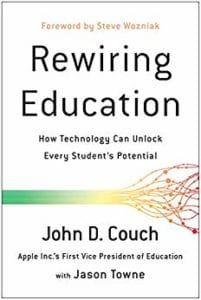
Rewiring Education: How Technology Can Unlock Every Student’s Potential
That was a big difference. That was a big change too because in the early days, I used to give Steve a hard time. I used to say, “Steve, it’s a strange ship that leaks from the top.” He would be so excited about the new products that he would go and tell people about it. When I came back, everything was buckled down in security. I even had to sign a non-disclosure agreement when I was shown future products.
Are you still on contract with them or have you left Apple? I wasn’t sure exactly where that stood.
Because of the book, the company decided that they didn’t want to set a precedent to a vice president writing a book. They asked me to move from a W-2 to a 1099. I retired on May 8 when the book was released but they’ve kept me on as a consultant for three quarters as I finish up some of the speaking engagements that Apple committed me to.
Your book is interesting. I was listening to the audio version of it. It’s titled Rewiring Education: How Technology Can Unlock Every Student’s Potential and that’s right up my alley. I’ve taught more than a thousand online business courses and I wrote my dissertation on emotional intelligence. Some of the things you’re talking about are also in in my book. I’m writing about curiosity, which interests me because you write a lot about things that fall into the creativity-curiosity realm. Some of the things I found that inhibited curiosity, failure was one of them. I found four things that were fear, assumptions, technology and environment. You could touch on a lot of environmental and assumption and fear in a lot of the things that I found. As I was going through your book, I’m like, “This is great.” You talked much more about the background. You get into technology later on in the book but you’re going into what is wrong with education and how we’re impacted. You talked about the natural creativity that we have as a child. How does that change from being a very young kid and middle school and so on?
I don’t think I did check to technology until chapter 13 because I talked about learning. What are the components of learning? One of my favorite quotes is Joi Ito from the Media Lab at MIT where he says, “Education is what people do to you. Learning is what you do for yourself.” I used to teach at Apple University in the early days and I would have banners and one of my banners was, “Curiosity is worth 100 IQ points.” We can go all way back to 1846, Friedrich Froebel invented kindergarten, which in German stands for children in the garden. His philosophy was that the children were creative beings, that they were created by a God. It was a creative God and that kindergarten should be all about creativity. They danced and they had music and they moved and they went into the gardens and nature. Then he built a set of tools called the Froebel gifts. There are nine different sets. In fact, they’re still used at MIT and in the Graduate School of Architecture. Frank Lloyd Wright was involved with these Froebel gifts.
It’s ironic that when they came over to the United States, Milton Bradley was the manufacturer of the Froebel gifts and they put the alphabet on it. It was the opposite of what Froebel was all about. When you take a look at our kindergarten classes now, they are all about worksheets and they’re all about literacy. That was not the original intention of Froebel. I thought about it, “Here we are, 130 years later and here comes Steve Jobs in 1978 where he sees technology being the tools are the gifts for creativity.” If you look at Land’s Creativity Test and you look at five-year-olds, it’s 80% of five-year-olds that got it in my talk are creative. By the time you get to be adults, only 2% are creative. We lost it along the way. In a sense, we’ve layered concrete on the creative parts of our being and asks us to be just all the same. If you read Dr. Rose’s book, The End of Average, you’ll see that there is no such thing as average. Everyone is unique and everyone is an individual. Our K-12 school system, which was defined by an essay in 1912 by the Board of Education funded by John D. Rockefeller, was not to have creative beings or not to bring creativity in the school but teach the kids how to do the same thing at the same time for the industrial age.
Here we are in 2018 and the majority of our schools are still buried in that type of thinking and assessments. What do we test? We test short-term memory. We don’t test potential. We don’t test creativity. We just test short-term memories. You hit on them and we don’t allow failure, which if you take a look at Thomas Edison, even take a look at Apple, we tried many things but some don’t work. One of the lessons that I learned from Bill Hewlett was more companies died from indigestion and starvation and that means we try to do too much. Steve turned that around and said we take as much pride in the eight things we don’t do as the two things that we do do. We’ve had some failures in getting to those two things that we do do.
[bctt tweet=”Curiosity is worth a hundred IQ points.” via=”no”]The purpose of the book was to start a conversation, to get parents to think a little bit differently. My favorite audience is the education boards because they’re my age. They’re grandparents and they know their grand kids are a lot smarter than the schools are allowing them to be. That’s a fun group to challenge. I don’t believe education is going to change top down. I believe it’s going to change bottom up as more people start to realize and explore some of the technology that’s out there. Adaptive learning, augmented reality and some of the new learning platforms that are coming on scene and that’s why the last chapter is Gandhi’s quote, “Be the change.”
You talked about a lot of things in your book in terms of change and how technology has changed so many things. I’m curious how has it changed the way people are learning or their ability to be curious? Are we letting technology do too much for us that we don’t desire the need to learn more?
It’s the opposite. The majority of technology in schools is being used strictly as a substitution. Instead of reading a book, we’re reading content up the internet.
Aren’t we asking questions about that as much as we could?
I don’t think so because there’s a huge training effort that needs to take place for our teachers. Our teachers need to realize that being a content expert you’re not alone anymore because all content is free and it’s all freely available. The real challenge is to put that content in a relevant context, something that’s relevant to the students. Where the students can be the creators of new content and not just the consumers of old content and where the students can work together in a collaborative manner because the Vygotsky’s research says that’s how we learn. When I went to school, collaboration was called cheating and then finally caught in a context that’s challenging, like the games are. We created a framework at Apple working with universities and other educational experts called challenge-based learning where the students solve real, relevant, community problems.
That’s so important. There was a time where we thought technology meant we can add videos to the class. Schoolhouse Rock was big and you even said private charter and online schools can be just as bad as the regular schools if they don’t do something different.
I had about an hour and a half meeting with Secretary Betsy DeVos. She’s very much a proponent for charter schools. Charter schools can be great but are you changing the pedagogy? Are you changing what we’re doing in the classroom or are you still basing it on memorization? It’s interesting because if you go back in history with Thomas Edison and John Dewey, Edison thought his videos would change education. They’re just as passive as anything. You just sit and listen and watch. You go back to Froebel, we need to be active. That’s the way our brains are designed to work in motion in different weather conditions. John Medina says, “If you were to design a learning environment that was directly opposed to the way our brains work, it would be a classroom.”
It’s unfortunate that there are a lot of situations that still need to be changed. I mentioned Todd Rose and you had mentioned him before. You talked about him and he’s being one of the smartest people in the Boston area. Can you tell the Todd story that you gave in the book?
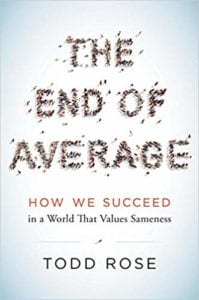
The End of Average: How We Succeed in a World That Values Sameness
Todd’s written three books. His first book was something like Square Peg or something like that, which was his story about him dropping out of high school with a D-minus average, getting his girlfriend pregnant and having two kids and working minimum wage when he decided to go back to school. The schools as well, you need to take some remedial course and this remedial course in time goes well. I want to take this graduate course that goes out once if I take those remedial courses because I have no interest, which gets into the chapter in our book on intrinsic motivation. He found a mentor and he took that course and now he runs the individuality lab at Harvard University. He wrote The End of Average, which is a great book. It shows there is no such thing as average. How does the word average even come into our vocabulary?
It has great stories about the need to challenge the US Air Force when they went from regular planes to jet propulsion planes and all the crashes. It turns out the reason was because they had designed a fixed cockpit seat for men of the average size. When they went out and interviewed 2,000 pilots, they found there was no one pilot that put the average size. The Air Force had to redesign the seats so that they were dynamic and can be changed like our car seats today and the crashes stopped. He’s got a book called Dark Horse, which is an interesting book. He references my story in there as a graduate student at UC Berkeley having passed all the prelims but the department wanting me to do something like proving programs correct. I wanted to work more on the interface of the world of computers to humans. I dropped out and six years later, I ran into Steve Jobs who challenged me with the exact interface challenge that I was interested in back in grad school.
That all falls into what I’m talking about in terms of environment. Some people push us in certain directions and that has such a big impact on our curiosity and other abilities. There are other things that impact it and it’s interesting that you have some background in epigenetics. Didn’t you work at DoubleTwist? What was that job?
After ten years of rebuilding the school and being involved on a day-by-day basis working with students and faculty, I came back and I was asked to be an entrepreneur in residence at Mayfield Fund, one of the VC funds on Sand Hill Road. They drop me into a number of different internet companies who were early out the game. They dropped me into one company called PanGEA and they were doing custom software for bioinformatics. Not only did I not know what bioinformatics was, I didn’t know how to spell it. That was a real challenge.
What we did was we used technology to process the data in the human genome with the goal of finding the protein that would be uniquely tailored to your DNA. After I left there and I changed the name of the company to DoubleTwist, we recreated a software environment with multiple software agents that would tell a researcher all about their sequences. Where it was patented, where it was found in literature and what it was used to. When Steve asked me to write education I thought, “We’ve got the same challenge in education. We need to find the gap in a student’s knowledge and deliver it to that student the appropriate learning activity to help him overcome that gap or we need to deliver a challenging learning activity to that student who’s bored in school.”
We’re treating everybody to this until we get to the lowest common denominator to keep everybody involved in a way, don’t we?
That’s exactly what we do is we teach to the average. The example that I used in the book and the charts are on my website that corresponds to the book was a fifth-grade class in Chicago, Illinois. When you look at it, you had one student reading at the eighth-grade level, one student reading at the first-grade level and six different reading levels in that class. The time it would take a teacher to find the appropriate learning activities for those six different levels is over 40 hours a week. In a sense, we’re asking our teachers to perform a miracle every week. Steve Jobs used to ask me to do that. I always respond, “I believe in miracles. I just don’t believe in scheduling.” That’s what we ask our teachers to do. You’re going to reach the need of each of the 30 or 35 kids that you have in the classroom within the week, when one kid’s reading of the first-grade level and one kid’s reading on the eighth-grade level. Then the irony of the data was when I looked at the math data, there was nobody above the fifth-grade level because we don’t allow kids could go ahead in math.
Sometimes the teacher is not ahead of where the student wants to go.
The parents can have a big impact on a child’s reading ability, as they start to read to them when they’re young and encourage an intrinsic motivation to read. Whereas it’s a little bit more of a challenge for parents to do that in mathematics.
It can be. When we talked about the genetics part of it, do you think you can be born with the good genes to be smarter or are we all born with the same abilities and some of it is just knocked out of us through environment?
We discussed this in the book and we talk about the impact of the environment. It’s not either or it’s both. You can be born with a little bit more genetic makeup, but your environment is going to have a big impact. The other thing is our DNA is not static, it’s dynamically changing. It’s an ongoing process. It’s both genetics being born but it’s also genetics and your environment and what you’re exposed to.
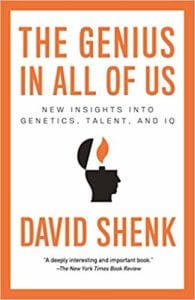
Education: The Genius in All of Us: New Insights into Genetics, Talent, and IQ
You mentioned David Shenk, the author of The Genius in All of Us. In the book, he wrote about how people can impact their genomes with their own behavior. I found that interesting.
That’s a whole neat area. The sad thing is not just that. In writing the book, I realized that so much academic research in terms of how the brain works, how important intrinsic motivation is because we never integrated itself into our K-12 classroom.
Why do you think that is?
First and foremost, our teachers are so overwhelmed right by the individuality of 30 or 40 kids in the classroom. There’s very little time and we provide very little professional development for them. We need to redefine the role of the teacher from a member of the union to a professional organization where there is ongoing training like my accountant. My accountant is in learning environments and professional development at the time.
Your chapter four was all about motivation and I can relate to your story of your daughter, Tiffany, who discovered her passion and went in a different direction. I have a daughter who I thought might be interested in getting an international business degree because she could speak four languages. It wasn’t her passion. Parents sometimes suggest things because you want your child to help them but then some parents will push them too far and say, “This is what you have to.” How do we know if we’re helping our child find the right thing or if we’re pushing them too much?
I have sixteen grandkids, ten of them are probably under the age of ten or eleven and the other five are in college. The ones that are in college aren’t necessarily steady in what they’re good at. I have a granddaughter that’s brilliant, straight A’s. She was in pre-med and now she’s decided to transfer to Savannah School of Art and Design. She’s got an incredible voice and very gifted in music and I’m just waiting for her to discover that and the value of that. She comes from a family particularly on the father’s side that probably pushed the medical. I was working with a fellow at John Hopkins University on their admissions because they’re finding that a lot of the students that they admit don’t want to be doctors. That they’ve been pushed into that. They’re trying to discover that in the admissions process rather than at the end.
I do meet a lot of doctors who stepped down and it surprises me to go through all that and then to not follow through. My husband is a doctor and I was a pharmaceutical rep for a long time and I do meet a lot. The ones who are in and see that happen to get frustrated with them too because they had to go through so much to get in. There is so much pressure.
I wonder if they just don’t burn out. I burnt out after the first five years at Apple as the fastest growing company in American history at the time. I stopped coding and wanted to help people. That’s why I ended up spending ten years in that K-12 school environment in terms of turning that school around.
What made you want to come back then?
came back not as a programmer, but I came back to run education. Steve told me this when I left Apple. He says, “This is great because you’re going to take some of the lessons that you’ve learned in business into the education community. Then you can bring back from the educations community lessons that we can learn about education.” Steve already saw that right from the very beginning. That’s just who Steve was. He was always looking down the road.
[bctt tweet=”There is no such thing as average. Everyone is unique and everyone is an individual. ” via=”no”]Do you think he would have been the one to reinvent education had he lived? Everybody keeps wanting to Uberize everything, to flip it and reinvent the industries. Everybody I talked to, all thinks education is the one that’s ripe for it but nothing really changes.
It’s like trying to move a 20,000ound marshmallow. How much you push into it, it doesn’t go anywhere. What we have to do over time is we have enough people who know the answer to be that change and start taking bites out of it. I do think that if Steve were still alive now, I would probably still be at Apple and he would be investing in what I believe we need to do, which is individualized learning. The role of technology is going to play a very big part in that in the same way iTunes Music can make recommendations on music based on your past preferences. I think the same technology can be used to make recommendations on learning activities based on the analytics that are available.
There’s so much that can be done. You tell a story of Elon Musk’s kids. I thought that was an interesting story. What people are looking for, we’re not getting. Can you share that story?
He started a school for his boys because they need to be solving problems and not memorizing.
He has the same outlook that you have because that’s what was horrible in history as a child because I don’t have the great ability to memorize. To me, it was memorizing dates a lot and math because you had to get an answer you couldn’t memorize it. When I saw your book, I’m like, “That’s exactly what I think.” You can memorize it but then it would be gone the next day after you took the test.
It’s the twenty-minute short-term memory. I see a lot of people go, “What’s John’s based learning because I’ve never been exposed to it?” Emerson’s quote, “People can only perceive what they’ve seen.” I use the example of California history in the book. Normally, what’s happening in California is every fourth grader needs to take California History and the publishers put a minimal amount of material into the textbook so it can get approved by the state. The teachers fundamentally teach about missions. You’ll get your dates and you’ll get your missions. They don’t talk about presidios. They don’t talk about the relationship between Mexico and California where history can survive. They give you a project and as a single person project again and you’re to build a mission out of sugar cubes. I’d say, “If it comes in anything other than sugar cubes, the parents were involved unless it was Minecraft. If it was Minecraft, you know the students did it.”
Let me give you an example of a challenge-based learning environment. You would tell the students you are William Randolph Hearst and they would go, “Who’s William Randolph Hearst?” You’re expecting to deliver that to them. You have to go discover it because a challenge-based learning is about discovery not about delivery. You would learn that he was the owner of the San Francisco Examiner and that he built Hearst Castle, which was a collection from all over the world. Now, you’re working as a team, you’re going outside of California. You’re looking at different animals that are coming in. You’re looking at different artwork coming in. You’re looking at architecture and he would throw a party every Friday night for his friends from Hollywood. He had a very long dining room table.
Your challenge is you’re going to throw a dinner party for those California individuals who made the biggest impact. Who would you invite and what would the seating chart look like? That’s an exploration. That’s working as a team. You’re going to find that first governor in California was Fremont and his goal was to annihilate the Indians. You’re going to have a debate on whether he should be invited. Then you’re going to say, “Where does Steve Jobs fit in? Where does Cesar Chavez fit in?” It’s an incredible learning environment because you’re motivated to discover it.
The thing I found though is the team activities are such a great idea. When I went to school, I was on a lot of teams to get my Bachelor’s and Master’s and whatever it is in business. Then of course as I taught business courses, we’ve had teams. What you find is so many people, you’ll get a few people like you who are really motivated and want to do the work and then you get a few who have probably their degrees right now because of people like you who are on their team. How do you get away from that?

Education: “People can only perceive what they’ve seen.”
Technology changes that a little bit too. If you look at the example that I use in the book about Jodie Deinhammer who teaches eleventh-grade Anatomy. Through challenge-based learning, the teacher doesn’t create the challenge. The kids create it out of what they’re interested in. Automatically, it’s relevant. They now become the creators. The kids wanted to take the materials that Jodie was teaching at eleventh-grade, repurpose it into a book and as courses for the younger kids and so they broke up in teams. What was interesting to me was the young girl who has given the assignment to do the illustrations for the book and the courseware was not considered of a great student. Now, she’s a medical illustrator because it was that project that opened up her ideas and her interest and passion in illustration. I was thinking about that, “What course did I take in high school that would even have given me a hint that there was a job in medical illustration or whether if I was ever interested in medical illustration?”
There are so many areas. We can’t be exposed to everything. It’s so hard.
Projects open us some more.
I’ve taught some team activities where we taught it on a Wiki, which was nice because you could see the backside of who was putting in what and when and how much time. I’m not as techie as you are by any means, but it did help me to see that. I like the idea of what you’re saying is giving them the idea of what they want to write about and there are so many ways to improve. What I was interested in doing with my research was to get people to look at their natural levels of curiosity because they’ve been so impacted by either these ideas that we don’t even find interesting or the things we do find interesting, the teachers don’t have time as you stated in your example.
Our path is well-defined for us. The rungs on the ladder are very well-defined. You go to school, you go to high school, you get into college, you get your degree, you become a professor or you go into the industry. You’ll enjoy Dr. Rose’s book called Dark Horse because he challenges that. He challenges it from a standpoint of fulfillment, of purpose. Do you have a fulfilled life, a purpose-filled life? He uses a lot of great examples. One of them he uses is the young lady who, with no education, just had a passion for the stars, became the first person to discover a planet since the 1800’s because of her passion.
There’s so much that we could do to help people become more curious, driven and motivated. Your book is important to open up the dialogue. You said it’s up to the parents that you think will change this.
I’ve had a lot of experience with schools in the State of Maine when Governor King gave every seventh grader in the state an iBook. Watching parents being against it because that’s not the way they emerged. Then finding out a year later that seeing their kids be creative and explorers and passionate about learning. Then a year later, the possibility of them going to eighth-grade and not having iBooks and it’s a total change of attitude on the parents’ part. I think there are going to be alternatives out there. I’m working with a company called Notion, which has spent $12 million and developed an incredible challenge-based learning curriculum from age three through fifteen in Mexico and South America. I think they have 40,000 or 50,000 students right now. They’re going to donate that to me for a nonprofit called the BeyondSchool.com. I want to make that available for preschool in Haiti, in Africa home schooling. There are going to be other efforts like this that parents are going to discover and even schools are going to discover because if I started preschool, I don’t run into all of the weight of the 20,000-pound marshmallow that exists in a day by day classroom.
Does it address emotional intelligence and soft skills in that type of stuff? That’s what I’d like to see more of in the K through 12.
[bctt tweet=”Children are creative beings. They were created by a creative God. ” via=”no”]We’re a little early on that. I worked with Trip Hawkins who works for me at Apple in the early days and then went off to do Electronic Arts. We created an emotional intelligence game working with Disney and others. The schools weren’t ready to go to accept it. We’ve got some work there too. It’s interesting because the revolution has begun. It’s just not equally distributed. My next book called Education Rewired is going to be great stories of schools that are doing very unique things on behalf of their students. Parents can say, “Where’s my 3D printer?” Whereas by learning laboratory, why aren’t my middle school students building solar cars?
We’re starting to see some of that with robotics and things of that nature. It’s ironic because people aren’t connecting the past dots with the future dots. I was in Kenya and I was on a panel with the ministers. They sell your company and the ministers were saying our goals are education and our goals are manufacturing. When they’re thinking about manufacturing, they were thinking about 1912 manufacturing, not the robotic manufacturing. They were not connecting the needs for robotic manufacturing back to the educational system. There’s a cyclic ecosystem that people seem to only have one of the three parts, yet it takes three parts to make it work.
With all that is happening now with innovation, with AI and so many people going to be removed from their jobs displaced or whatever, do you see that we’re going to have a need for higher education or reeducation? Where do you think that stands?
Yes, I do. It’s one of the reasons that we started Woz U. It was to start and address some of those questions. You’d be able to get rebuilt if you will at fourteen weeks for cybersecurity for jobs that are there or are going to be there. It’s interesting because a friend of mine, Caleb, at the MIT Lab has built an operating system for growing vegetables. He’s got a great TED Talk called, Even Broccoli has a URL, and they’re democratizing farming by growing plants inside these chambers that can be as large as you want it to be so that we can’t grow food in the desert. Food growing isn’t democratized. Certain regions can do it. Other regions can’t. When he lifted his team, he’s got botanists, biologists, computer scientists and mechanical engineers. It is a collection of talent. When I look at our schools changing a little bit was withheld with chemistry, biology, medicine and computer science coming together, but we’re still fundamentally teaching silos. I read a paper where they did a study of the last 100 Nobel Prize winners and one of the consistent characteristics of those winners was they cut across disciplines and yet we’re still teaching algebra separate from chemistry, separate from everything else.
It’s interesting to see what will happen with the future of education. I was fascinated by your book. I didn’t get to read all of it. I read most of it. It was so fascinating and I was fascinated, especially chapter four because it’s all dealing with the things that I’m dealing with motivation and drive and curiosity and all that but I went through and I read most of it. I thought it was good. There are so many people that need to be discussing this not just teachers, not just administrators, parents but everybody. It’s a great book and a lot of people should check it out. Could you tell them how they could find it if they’re interested?
Amazon has it for $16. I have RewiringEducation.com, which is a website that has a lot more backup material and material from other individuals like Sir Ken Robinson. I have a Facebook page, Eden Inspirations. The goal was to start a conversation and then we’ll hopefully continue that conversation with the next one, which are going to be case studies. Things that people can identify with and bring to their schools and then question, “How come we’re not doing this?”
I enjoyed having this conversation with you. Thank you so much for being on the show, John.
It’s my pleasure.
I want to thank John so much for being my guest. What a great book. What a great guest. I enjoyed it. If you’re interested in finding out more about my book on curiosity, you can go to CuriosityCode.com where you can also find out more about taking the Curiosity Code Index, the CCI, which is available there as well. I hope you enjoyed the show and I hope you join us for the next episode of Take the Lead Radio.
Important Links:
- John Couch
- Rewiring Education: How Technology Can Unlock Every Student’s Potential
- DesTechAZ
- The End of Average
- Square Peg
- Dark Horse
- The Genius in All of Us
- BeyondSchool.com
- Woz U
- RewiringEducation.com
- Eden Inspirations on Facebook
- CuriosityCode.com
About John Couch

John Couch was the 54th employee at Apple and became Vice President of software. He retired in his 30s and went on to revitalize a faith-based school in California and worked on several other projects. Later, Steve Jobs brought him back as the first VP of Education at Apple. He has a new book titled Rewiring Education, How Technology Can Unlock every Student’s Potential.

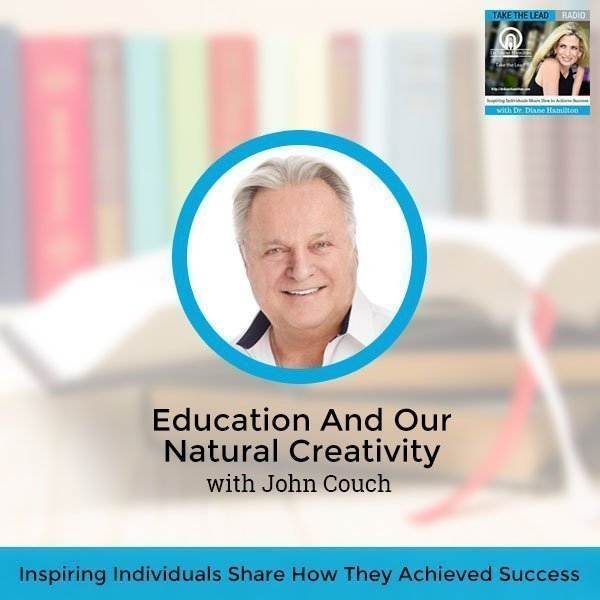

0 Comments